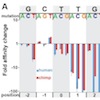 Microfluidic affinity and ChIP-seq analyses converge on a conserved FOXP2-binding motif in chimp and human...
Microfluidic affinity and ChIP-seq analyses converge on a conserved FOXP2-binding motif in chimp and human...Christopher S. Nelson1, Chris K. Fuller, Polly M. Fordyce, Alexander L. Greninger, Hao Li, and Joseph L. DeRisi
NAR, 2013Abstract: The transcription factor forkhead box P2 (FOXP2) is
believed to be important in the evolution of human
speech. A mutation in its DNA-binding domain
causes severe speech impairment. Humans have
acquired two coding changes relative to the
conserved mammalian sequence. Despite intense
interest in FOXP2, it has remained an open
question whether the human protein’s DNAbinding
specificity and chromatin localization are
conserved. Previous in vitro and ChIP-chip studies
have provided conflicting consensus sequences for
the FOXP2-binding site. Using MITOMI 2.0
microfluidic affinity assays, we describe the
binding site of FOXP2 and its affinity profile in
base-specific detail for all substitutions of the
strongest binding site. We find that human and
chimp FOXP2 have similar binding sites that are
distinct from previously suggested consensus
binding sites. Additionally, through analysis of
FOXP2 ChIP-seq data from cultured neurons, we
find strong overrepresentation of a motif that
matches our in vitro results and identifies a set of
genes with FOXP2 binding sites. The FOXP2-binding
sites tend to be conserved, yet we identified 38
instances of evolutionarily novel sites in humans.
Combined, these data present a comprehensive
portrait of FOXP2’s-binding properties and imply
that although its sequence specificity has been
conserved, some of its genomic binding sites are
newly evolved.
